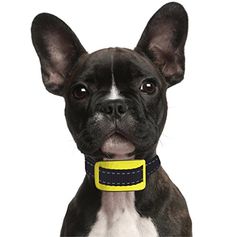Last Updated on June 22, 2024
As a devoted dog parent to a spirited Chihuahua named Pepe, I understand the frustration of excessive barking. When Pepe’s high-pitched yaps started to test the limits of my patience (and my neighbors’), I began exploring solutions, which led me to the often-debated world of bark collars. Are they safe for small dogs? Let’s dig in and uncover the truth.
Understanding How Bark Collars Work
 Before we address safety concerns, let’s clarify how bark collars work. These collars use various methods to deter barking, including:
Before we address safety concerns, let’s clarify how bark collars work. These collars use various methods to deter barking, including:
- Static Correction: These collars deliver a mild electric shock when a bark is detected.
- Citronella Spray: These collars release a harmless spray of citronella, which dogs find unpleasant, interrupting their barking.
- Ultrasonic Emission: These collars emit a high-pitched sound that’s only audible to dogs, deterring them from barking.
- Vibration: These collars vibrate when a bark is detected, providing a distraction that interrupts the behavior.
Addressing the Safety Concerns: Size and Sensitivity Matter
Now, to the heart of the matter: are bark collars safe for small dogs? The answer, like most things in life, is nuanced. Small dogs, with their delicate frames and sensitive natures, require special consideration.
- Pepe’s Experience: I’ll admit, I was hesitant to use a bark collar on Pepe. He’s a tiny but mighty Chihuahua, and I worried about the impact of even the mildest correction. After extensive research and consulting with our veterinarian, we decided to try a citronella collar with adjustable spray intensity. Thankfully, the unpleasant scent was enough to deter his barking without causing him any distress.
Potential Risks: Proceed with Caution
While bark collars can be effective, it’s crucial to acknowledge the potential risks, especially for small dogs:
- Overstimulation and Anxiety: Even on the lowest setting, some collars can be too intense for small dogs, leading to anxiety, fear, and even behavioral issues.
- Physical Discomfort: An ill-fitting collar can cause discomfort, chafing, and even injury to a small dog’s delicate skin and trachea.
- Ineffectiveness for Certain Barks: Some collars may not differentiate between your dog’s barks and other sounds, leading to unnecessary corrections.
Alternatives to Bark Collars: Exploring Humane Solutions
If you’re uncomfortable with bark collars, rest assured, there are alternative solutions:
- Positive Reinforcement Training: Teaching your dog to “speak” and “quiet” on command empowers them and strengthens your bond.
- Addressing Underlying Issues: Excessive barking can stem from boredom, anxiety, or even medical conditions. Consult with your veterinarian or a certified dog trainer to rule out any underlying issues.
- Environmental Enrichment: Provide your dog with plenty of mental and physical stimulation to prevent boredom-induced barking.
Making Informed Decisions: Your Dog’s Well-being is Paramount
Ultimately, the decision of whether or not to use a bark collar on your small dog is a personal one. Weigh the potential benefits and risks carefully, and always prioritize your dog’s well-being. Remember, there’s no one-size-fits-all solution.
While the citronella collar worked for Pepe, I understand it’s not the right solution for every dog. If you’re considering a bark collar, I urge you to consult with your veterinarian or a certified dog trainer. They can assess your dog’s individual needs and guide you towards the safest and most effective approach.
Navigating the World of Bark Collars: Types and Considerations
If, after careful consideration and professional guidance, you decide to explore bark collars, it’s essential to choose wisely. Here’s a closer look at the different types and factors to consider:
Citronella Collars: A Scent-sational Approach
As I mentioned earlier, citronella collars release a harmless spray of citronella when a bark is detected. Most dogs find the scent unpleasant, interrupting their barking. These collars are often considered a more humane alternative to static correction collars, especially for small dogs. Pepe can attest to the effectiveness of citronella! The first time the collar sprayed, he was startled but quickly learned to associate the unpleasant scent with his barking. The best part? It didn’t cause him any pain or anxiety.
Ultrasonic Collars: Sounding the Retreat on Barking
Ultrasonic collars emit a high-pitched sound that’s only audible to dogs. This sound can startle or distract dogs, interrupting their barking. However, it’s important to note that some dogs may become desensitized to the sound over time.
Vibration Collars: A Gentle Buzz to Curb the Bark
Vibration collars deliver a gentle vibration when a bark is detected. This sensation can startle or distract dogs, interrupting their barking. Vibration collars are often considered a more humane alternative to static correction collars, but their effectiveness can vary depending on the dog’s sensitivity.
Static Correction Collars: Proceed with Utmost Caution
Static correction collars deliver a mild electric shock when a bark is detected. While these collars can be effective, they should be used with extreme caution, especially on small dogs. Always start with the lowest setting and closely monitor your dog’s reaction.
A Word of Caution: I cannot stress enough the importance of using static correction collars responsibly. An inappropriate shock level or prolonged use can cause physical and psychological harm to your dog.
Choosing the Right Collar: Factors to Consider
Selecting the right bark collar for your small dog is crucial for their well-being and the effectiveness of the training. Consider these factors:
- Size and Weight: Choose a collar specifically designed for small dogs and ensure a snug but comfortable fit.
- Temperament: A dog’s temperament should guide your collar choice. A sensitive dog might respond better to a citronella or vibration collar, while a more stubborn dog might require a different approach.
- Barking Triggers: Identify what triggers your dog’s barking. If it’s primarily boredom, environmental enrichment might be a more effective solution than a bark collar.
- Professional Guidance: Consult with your veterinarian or a certified dog trainer to determine the most appropriate type of collar and training approach for your dog.
Bark Collars: A Tool, Not a Magic Solution
Remember, bark collars are just one tool in your training arsenal. They should never be used as a substitute for proper training, socialization, and addressing underlying behavioral issues. By combining a humane bark collar with positive reinforcement techniques and a holistic approach to your dog’s well-being, you can help them find their inner “quiet” button.
 Dog N Treats All dogs deserve to be pampered
Dog N Treats All dogs deserve to be pampered



